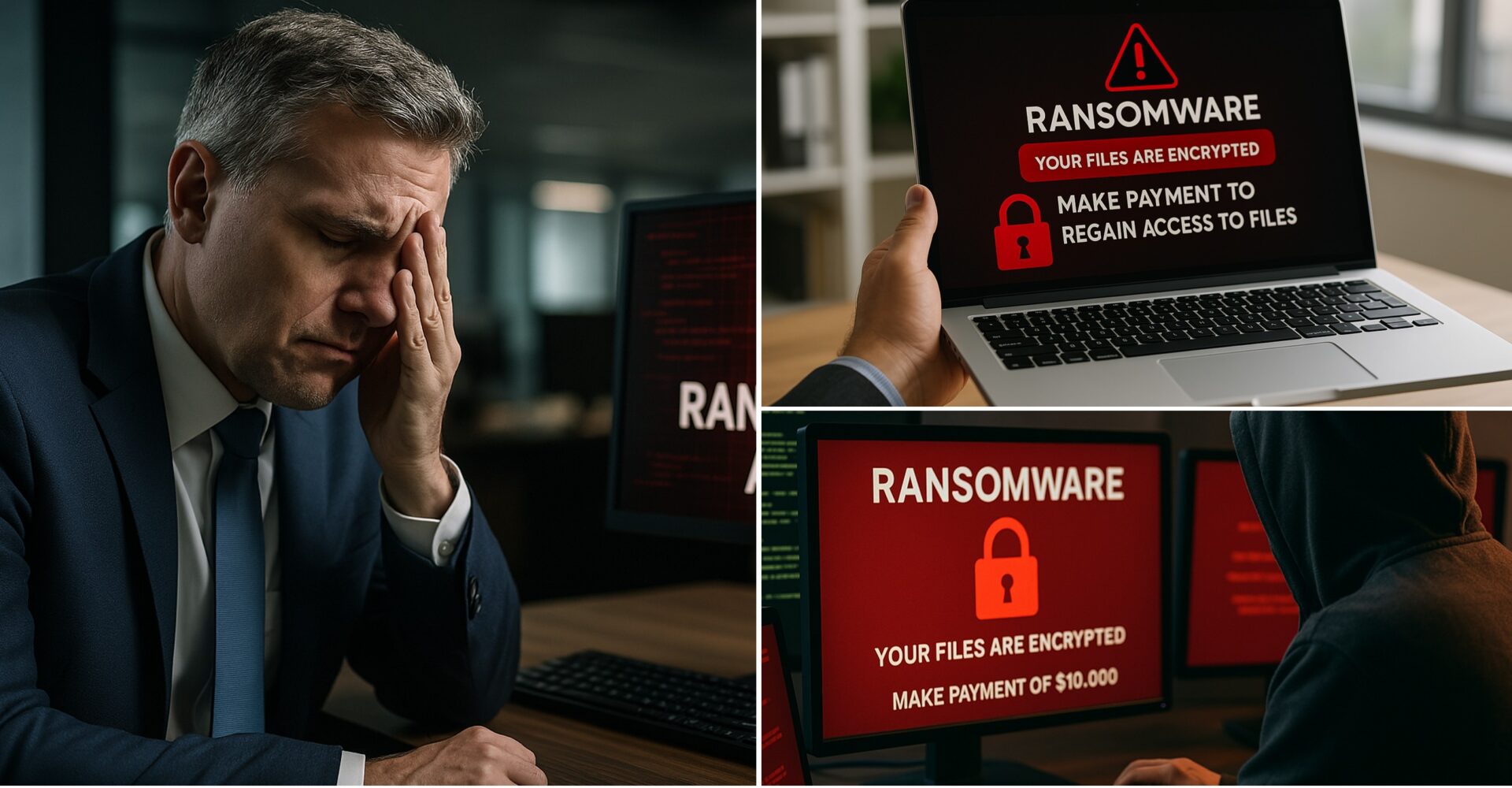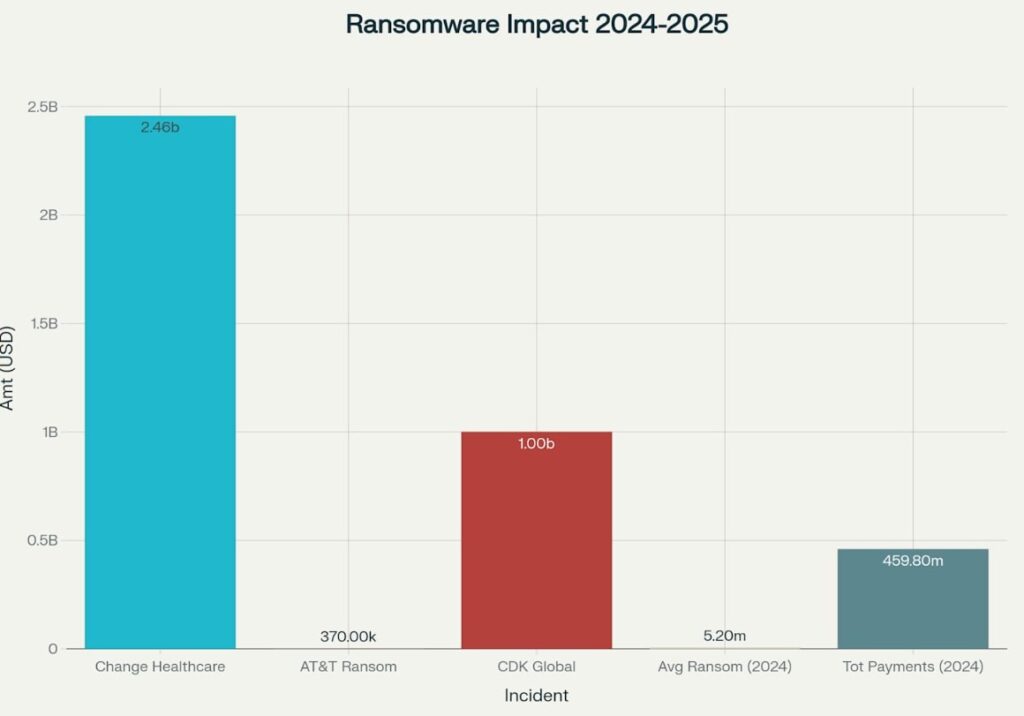The ransomware landscape has evolved into a multi-billion-dollar criminal enterprise that’s targeting businesses of all sizes with unprecedented sophistication and financial impact. Recent data reveals staggering financial losses that should serve as a critical warning for every business leader in America.
The Financial Reality of Modern Ransomware Attacks
Financial impact of major ransomware attacks and ransom payments in 2024-2025
Ransomware attacks represent one of the most devastating threats to business resilience and financial stability, with impacts that extend far beyond initial ransom demands to fundamentally undermine organizational operations and long-term viability. The economic devastation caused by ransomware attacks in 2024-2025 has reached alarming new heights, with individual incidents resulting in losses exceeding tens of millions of dollars. Organizations across various sectors are facing not just ransom demands but comprehensive financial impacts, including operational downtime, recovery costs, regulatory fines, and long-term reputational damage.
Immediate Operational Disruption and Revenue Loss
Ransomware attacks cause immediate and severe operational paralysis, with 58% of organizations forced to shut down operations entirely following an attack, up from 45% in 2021. The average system downtime has reached 24 days, resulting in significant revenue losses and operational disruptions. This operational standstill affects every aspect of business functionality, from customer service to supply chain management, creating cascading effects throughout the organization.
The revenue impact is particularly severe, with 66% of organizations experiencing significant revenue loss following an attack. More concerning is the trend showing that 40% of companies reported substantial revenue loss in recent studies, up from just 22% in 2021, indicating that ransomware’s revenue impact is becoming increasingly devastating over time.
The Hidden Costs Beyond Ransom Payments
While ransom payments grab headlines, the total cost of a ransomware attack extends far beyond the initial demand. Organizations typically face:
- Operational downtime costs: Lost productivity and revenue during system recovery
- Incident response expenses: Emergency cybersecurity consultants and forensic investigations
- Regulatory compliance fines: Penalties for data breaches and security failures
- Customer compensation: Costs related to identity monitoring and breach notifications
- Infrastructure rebuilding: Complete system reconstruction and security upgrades
- Reputational recovery: Marketing and public relations efforts to restore trust
Industry Impact and Vulnerability Patterns
Healthcare Systems Under Siege
Healthcare organizations remain prime targets due to their critical nature and often outdated security infrastructure. The sector has experienced some of the most financially devastating attacks, with hospitals forced to pay substantial ransoms to restore life-critical systems.
Financial Services in Crosshairs
Banks, credit unions, and financial service providers face particularly high-value attacks due to the sensitive financial data they process and their regulatory obligations for continuous operations.
Manufacturing and Supply Chain Disruption
Manufacturing companies are increasingly targeted as cybercriminals recognize the cascading impact of production shutdowns on global supply chains, making these organizations more likely to pay substantial ransoms quickly.
The Evolution of Ransomware-as-a-Service
Modern ransomware operations have professionalized into sophisticated criminal enterprises offering “Ransomware-as-a-Service” (RaaS) models. This democratization of cybercrime has led to:
- More frequent and targeted attacks
- Higher success rates for criminals
- Increased ransom demands
- More sophisticated attack vectors
- Greater focus on data exfiltration alongside encryption
Critical Action Items for Business Leaders
Immediate Risk Assessment
- Conduct comprehensive cybersecurity audits that focus on identifying and mitigating ransomware vulnerabilities.
- Evaluate current backup and disaster recovery capabilities
- Review cyber insurance coverage and exclusions
- Assess third-party vendor security practices
Strategic Security Investment
- Implement a multi-layered security architecture, including endpoint detection and response (EDR)
- Deploy advanced email security solutions to block phishing attempts
- Establish network segmentation to limit attack spread
- Invest in employee security awareness training programs
Incident Response Preparedness
- Develop and regularly test ransomware-specific incident response plans
- Establish relationships with cybersecurity incident response firms
- Create communication protocols for stakeholders, customers, and regulators
- Implement offline backup systems that cannot be compromised during attacks
The ROI of Proactive Cybersecurity for Small to Medium-Sized Businesses
Cybersecurity ROI: The SMB Reality Check – Prevention vs. Recovery Cost Analysis for SMBs
Small to medium-sized businesses face disproportionate cybersecurity risks with limited resources to recover from attacks. For SMBs, proactive cybersecurity investment delivers a significantly higher ROI of 4:1 to 15:1, as smaller organizations often lack the financial resources to absorb major cyber incidents.
- Average proactive cybersecurity program cost for SMBs: $25,000-$150,000 annually
- Average ransomware attack cost for SMBs: $120,000-$1.24 million
- Potential savings ratio: 5:1 to 25:1 for comprehensive SMB programs
Real-World ROI Calculations for SMBs
For $5 million revenue SMB (50 employees):
- Recommended cybersecurity budget: $150,000-$250,000 annually (3-5% of revenue)
- Single ransomware attack cost: $380,000-$850,000
- ROI breakeven: Preventing just ONE attack every 2-3 years
- Net savings: $130,000-$700,000 per prevented incident
For $15 million revenue SMB (100-150 employees):
- Recommended cybersecurity budget: $450,000-$750,000 annually
- Average SMB ransomware cost: $650,000-$1.1 million
- ROI breakeven: 1.5-2 years of investment
- Five-year net benefit: $1.8-$3.2 million
For a $million in revenue for a small business (10-25 employees):
- Recommended cybersecurity budget: $30,000-$50,000 annually
- Average small business attack cost: $120,000-$200,000
- ROI breakeven: 2-4 years
- Critical survival factor: 60% of small businesses close within 6 months of a cyber attack
SMB-Specific Budget Allocation Recommendations : 3-5% Revenue Allocation: SMB Benchmarks
Current SMB spending patterns reveal dangerous gaps:
- 78% of SMBs spend less than 2% of revenue on cybersecurity
- Only 14% of SMBs meet the recommended 3-5% revenue allocation
- SMBs spending <1% of revenue face 580% higher breach likelihood
Industry-specific SMB recommendations:
- Professional services firms ($2-10M revenue): $60,000-$300,000 annually
- Healthcare practices ($1-5M revenue): $30,000-$200,000 annually
- Manufacturing SMBs ($5-25M revenue): $150,000-$800,000 annually
- Retail businesses ($1-15M revenue): $30,000-$500,000 annually
Employee Training ROI: Critical for Resource-Constrained SMBs
Training investment for SMBs:
- Annual per-employee cost: $100-$200 (lower due to group licensing)
- Recommended budget allocation: 20-25% of total cybersecurity budget
- Minimum viable program: $5,000-$15,000 annually for 25-75 employees
SMB-specific measurable returns:
- SMBs face 350% higher phishing attack rates than enterprises
- Effective training reduces SMB incident likelihood by 65-80%
- Untrained SMB employees click on malicious links at a 45% rate vs. 8% for trained staff
Cost-benefit analysis for a 50-employee SMB:
- Annual training investment: $5,000-$10,000
- Single prevented incident savings: $200,000-$600,000
- ROI: 2,000% to 12,000%
Automated Backup and Recovery Solutions for SMBs
SMB-appropriate investment levels:
- Cloud-based backup solutions: $3,000-$25,000 annually
- Hybrid backup systems: $10,000-$50,000 annually
- Recommended allocation: 15-20% of cybersecurity budget
SMB recovery cost comparison:
- SMBs with robust backups: Average recovery cost is $85,000
- SMBs without adequate backups: Average recovery cost is $420,000
- Savings differential: $335,000 per incident
- ROI timeline: 3-12 months
Business continuity impact for SMBs:
- Recovery time with automated systems: 8-48 hours
- Recovery time without systems: 1-3 weeks
- Revenue protection: $5,000-$50,000 per day of avoided downtime
- Critical factor: 93% of companies that lose data for 10+ days file for bankruptcy within one year
Cyber Insurance: Essential Risk Transfer for SMBs
SMB-focused premium costs and coverage:
- Annual premiums: $2,000-$15,000 per $1 million coverage
- Typical coverage limits for SMBs: $1-5 million
- Recommended allocation: 8-12% of cybersecurity budget
SMB claims and ROI data:
- Average SMB cyber insurance claim: $425,000
- Claim approval rate for SMBs: 82-88%
- Premium-to-claim ratio: 1:20 to 1:35 (exceptional ROI for SMBs)
SMB-specific coverage benefits:
- Incident response services: $25,000-$150,000 value
- Legal and regulatory support: $15,000-$100,000 value
- Business interruption coverage: 25-40% of total claim value
- Reputation management: $10,000-$50,000 value
SMB-Specific Advanced ROI Considerations: Compliance and Regulatory Benefits for SMBs
SMB regulatory exposure:
- State data breach notification costs: $15,000-$85,000 per incident
- Industry-specific fines (healthcare, finance): $25,000-$500,000
- Customer notification costs: $150-$300 per affected individual
Proactive compliance investment for SMBs:
- Annual compliance program cost: $15,000-$75,000
- Average SMB regulatory penalty: $180,000
- ROI: 2:1 to 12:1
Competitive Advantage and Revenue Protection for SMBs
Customer trust impact on SMBs:
- 38% of SMB customers switch providers after a data breach
- Average customer lifetime value loss: $25,000-$150,000 for key accounts
- Security certifications benefit: 25-40% competitive advantage in B2B sales
Market survival statistics:
- 60% of SMBs close within 6 months of a cyber attack
- 40% of attacked SMBs lose 20%+ of customers permanently
- Recovery timeline for SMB reputation: 18-36 months
Contact CMIT Solutions if you need help with the Practical SMB Implementation Timeline and Phased ROI
Don’t Become the Next Statistic
The ransomware threat landscape is expected to continue evolving in 2025, with criminals employing artificial intelligence and increasingly sophisticated social engineering tactics. Organizations that fail to prioritize cybersecurity preparedness risk joining the growing list of ransomware victims, who face catastrophic financial losses.
Act Today
The time for reactive cybersecurity approaches has passed. Business leaders must treat ransomware preparedness as a critical business continuity issue requiring immediate attention and substantial investment. Schedule a comprehensive cybersecurity assessment with qualified professionals and begin implementing robust defense strategies before your organization becomes the next headline.
Ready to protect your business from ransomware threats? Contact CMIT Solutions cybersecurity experts today for a complimentary risk assessment and learn how to safeguard your organization’s future.
#RansomwarePrevention #CybersecurityROI #BusinessContinuity #DataProtection #CyberResilience #ITSecurity #RiskManagement #CyberInsurance #IncidentResponse #BusinessSecurity #CyberThreats #BrowserSecurity #CyberRisk #GenAI #rutgers #remba #mcrcc #mccc #newjersey #njccic #njsbdc #sbdc #njlaw #cpas #nonprofit #education #school #cmitsolutions #ExtensionSecurity #ThreatIntelligence #ZeroTrust #DataPrivacy #Phishing #Malware #CyberDefense #SecureYourData #CybersecurityTips #Tech #DigitalSafety #StaySafeOnline #Security



